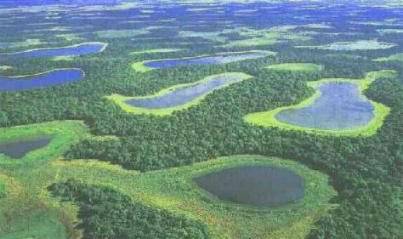|
Pressure
on the Pantanal
Can
Brazil champion the environmental and ecological cause and preserve
the wonders of the Pantanal? Or will it fall victim to pressure
from big business?
By Roderick
Eime
The expansive
Pantanal wetlands form a wide soggy navel in the midriff of the
continent of South America. Predominantly in Brazil, the Pantanal
overlaps into Bolivia and Paraguay and occupies an area around
half the size of France and was inscribed by UNESCO in 2000 for
its biological importance.
 This
ecologically abundant region is anything but a swampy wasteland
and is billed by many experts as the world's largest remaining
wetland system playing host to over 650 species of birds, 80 species
of mammals, 50 species of reptiles, 250 species of fish and more
than 90,000 types of plants. This
ecologically abundant region is anything but a swampy wasteland
and is billed by many experts as the world's largest remaining
wetland system playing host to over 650 species of birds, 80 species
of mammals, 50 species of reptiles, 250 species of fish and more
than 90,000 types of plants.
Well-travelled
naturalists extol with great verve the wonders of the Pantanal.
Unlike the dense jungles of the Amazon which taunt and tease tourists
by hiding their rich lode of natural treasures deep in the thick
leafy swamps, the comparatively wide open spaces of the Pantanal
offer much greater access to the wildlife. Ecstatic "birders"
have reported seeing as many as one hundred species in a single
day including jabiru, wood stork, roseate spoonbill, southern
screamer, bare-faced and green Ibises, golden -collared and hyacinth
macaws - the world's largest parrot.

Milling around
the broad waterways are herds of capybara (the world's largest
rodents) as well as tapir, marsh deer, jaguar, giant river otter,
giant anteater, spectacled caiman and giant monitor lizard.
Despite these
impressive credentials, the Pantanal plays second fiddle to the
Amazon region in the tourism stakes. Instead it relies heavily
on agricultural production, specifically soya beans, rice and
sugar cane.
Brazil, Argentina,
Bolivia and Paraguay all depend on the productivity of the wider
region and now an ominous cloud hangs over this wildlife paradise.
For more than a decade, the enormous and incredibly ambitious
Hidrovia canal project has threatened to transform the Pantanal
by dredging some 7.3 million cubic metres of silt and rocks to
allow ocean-going vessels to navigate the fragile eco-systems
of the Paraguay and Parana Rivers.
In 1999, Brazil
backed away from the plan due to severe environmental concerns.
Environmentalists savoured a brief victory and the relatively
few tourism operators breathed a collective sigh of relief. However,
the plan has recently resurfaced; driven this time, not by government
enthusiasts, but by private landowners, ranchers and industrialists.
Like many
other examples around the world, the elevation of eco-tourism
in the region is one way of raising awareness of the looming danger.
Despite its low tourism profile, small hotels, lodges and hostels
are opening up in the heart of the region and wide-eyed nature-lovers
are venturing out into the wetlands in boats, buses and even on
horseback.
A good deal
of mixed emotion exists within the Pantanal communities, with
opposing camps engaging in vigorous discussion over the supposed
economic benefits versus the feared environmental impact.
"The
whole thing will only benefit big business," says one fishing
boat captain who fears pollution from the freighters will ruin
his livelihood.
"Maybe
the new waterway will create more jobs in the region," surmises
the chief of the local Enxet tribe whose people don't have money
to buy staple items or medicine.
And there
are those who are not afraid to voice their gravest fears, like
leading environmental activist, Oscar Rivas, of the Paraguayan
group, Sobrevivencia.
"It'll
be hell's highway", he said in an interview with National
Geographic, "Numerous studies have shown that the dredging
of the rivers could seriously affect the Pantanal. There's a chance
it will become a desert."
Resources:
www.panatal.org
|  Sponsored
Link: Sponsored
Link:
Adventure
Associates is Australia's most experienced tour operator
to South America. For more information about tour packages
to the Pantanal and Brazil, contact Robyn Smith on 02 9389
7466 or 1800 222 141. Visit the website for more details:
www.adventureassociates.com
|
|